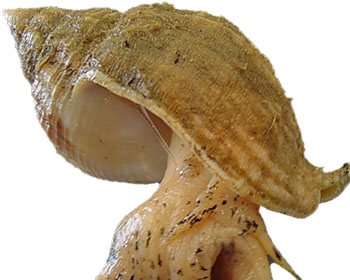|

Whelk, Buccinum undatum. (Photo Credit: Hans Hillewaert/CC BY-SA 3.0)
First whelk fishery enters MSC programme
 (FRANCE, 4/30/2014)
(FRANCE, 4/30/2014)
The Comité Régional des Pêches Maritimes de Basse Normandie (CRPM-BN), the Normandie Fraîcheur Mer association and the Marine Stewardship Council (MSC) announced the start of the MSC assessment of the Granville Bay whelk fishery. It is the first whelk fishery worldwide to enter MSC programme.
Very popular among seafood lovers, whelk (Buccinum undatum) is a carnivorous gastropod found in shallow coastal areas (<30m). It remains mostly immobile and hidden, and uses its foot, which is the edible part, to move and feed.
From Canadian shores to Siberian seas, the geographic distribution of whelk is extremely wide. In France, more than 75 per cent of the entire French whelk production comes from Normandy. The greater part of fishing and production occurs between Granville and Cap de la Hague.
Granville Bay whelk fishery, which is managed by the CRPM-BN, includes 72 whelk fishing vessels that use traditional trap methods and that bring in between 6,000 and 9,000 tonnes of whelk each year, sold by auction to fishmongers, fish merchants and processors.
In the decade from 1970 to 1980, whelk consumption and production grew considerably, which caused the resource to become endangered. In 1985, the industry started to adopt a deliberate policy to restore the whelk stock.
Daniel Lefèvre, CRPM-BN Chairman explains: “Thanks to intensive cooperation between the Regional Fishing Board, the Syndicat Mixte pour l’Equipement du Littoral (SMEL), IFREMER, the University of Caen and Normandie Fraîcheur Mer (NFM), we were able to improve the acquisition of biological data and define technical measures that could contribute to restoring the fishery.”
Arnaud Manner, head of Normandie Fraîcheur Mer (NFM), the association of fishing industries in Lower-Normandy, steered a pre-assessment of Granville Bay whelk fishery in 2008: “This pre-assessment allowed us to establish a more efficient application and to estimate the impact of the regulatory measures taken such as a maximum length of 12 metres for vessels, a maximum of 720 baited pots allowed per vessel, the minimum catching size of whelks, a limited fishing period and less licences granted.”
Laurence Mace from SMEL, responsible for the scientific monitoring of the whelk fishery, alongside the CRPM-BN, confirms that the measures show positive trends: "The number of whelk kilograms landed per trap increased from an average of just under 1kg in 2009 to nearly 1.5 kg in 2013; while at the same time, the market size of whelks sold increased!”
[email protected]
www.seafood.media
Information of the company:
|
Address:
|
Marine House, 1 Snow Hill
|
|
City:
|
London
|
|
State/ZIP:
|
England (EC1A 2DH)
|
|
Country:
|
United Kingdom
|
|
Phone:
|
+44 (0)20 7246 8900
|
|
Fax:
|
+44 (0)20 7246 8901
|
|
E-Mail:
|
[email protected]
|
|
Skype:
|
https://www.instagram.com/mscecolabel/
|
More about: 
|
|
|
|



